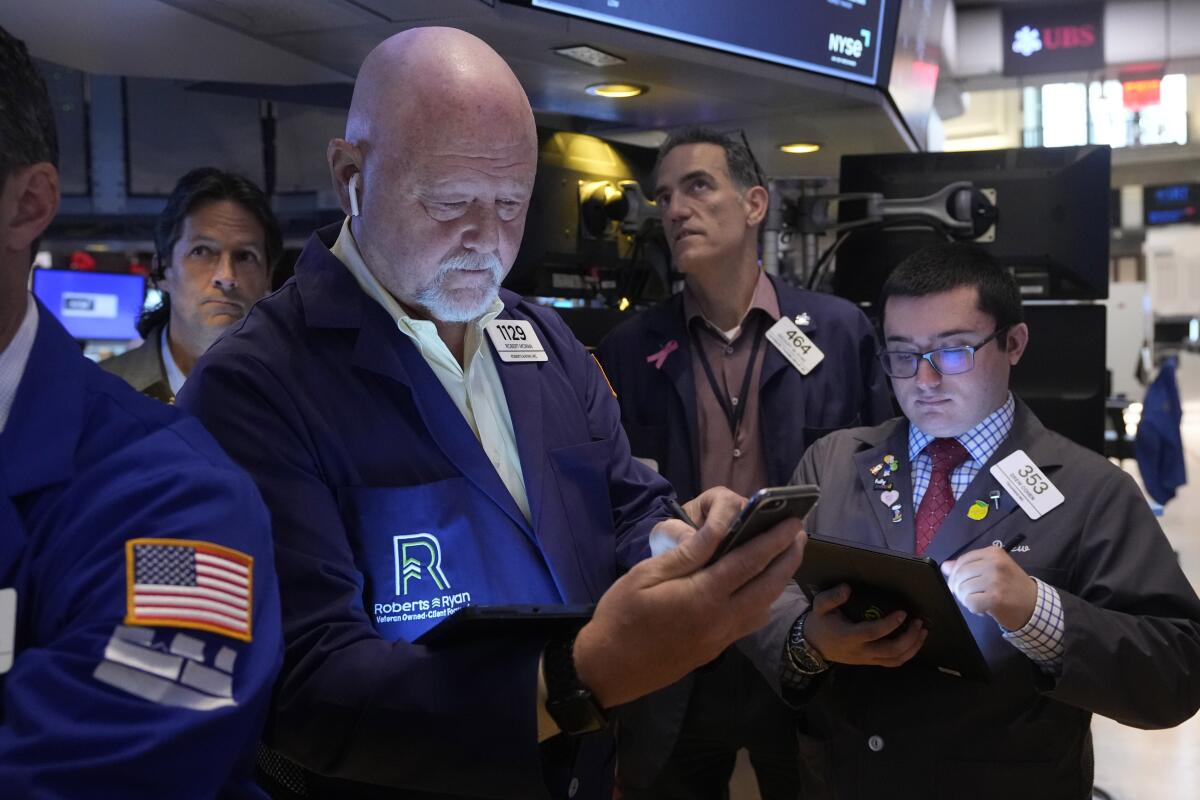Wall Street pushes its winning streak to 8 days, longest of the year

- Share via
NEW YORK — U.S. stocks climbed Monday as Wall Street pulls closer to its record heights after its roller coaster of a summer.
The Standard & Poor’s 500 rallied 1% for its eighth straight gain. That clinched its longest winning streak since November and followed up on the index’s best week of the year. It’s back to within 1% of its all-time high after falling close to 10% below the mark earlier this month.
The Dow Jones industrial average gained 236 points, or 0.6%, and the Nasdaq composite jumped 1.4%.
Advanced Micro Devices helped drive the market after saying it would buy ZT Systems, a supplier in the cloud computing and artificial intelligence industries, in a cash-and-stock deal valued at $4.9 billion. The chip company’s stock rose 4.5%.
Another chip company, Nvidia, was the single strongest force pushing the S&P 500 upward after it rose 4.4%. It’s clawed back most of its sharp losses from earlier in the summer, which were triggered by worries that investors had sent its stock price too high amid their frenzy around AI technology.
They helped offset a 4.8% drop for Guess? Inc., which said its chief financial officer is stepping down to pursue another opportunity. The apparel and accessories company said it has begun a search for its next CFO and appointed an interim.
All told, the S&P 500 rose 54.00 points to 5,608.25. The Dow advanced 236.77 points to 40,896.53, and the Nasdaq composite jumped 245.05 points to 17,876.77.
Trading was quiet elsewhere, including in the bond market. Treasury yields held relatively steady ahead of what’s likely to be financial markets’ main event for the week: a speech on Friday by Federal Reserve Chair Jerome H. Powell.
The setting for the speech in Jackson Hole, Wyo., has been home to some big policy announcements by the Fed in the past. Expectations aren’t that high this time around, with nearly everyone already expecting the Fed will begin cutting interest rates next month.
That would be the first such cut since the Fed began hiking rates drastically in early 2022, hoping to slow the economy by enough to stifle inflation but not so much that it causes a recession. With inflation slowing from its peak above 9% two summers ago, Fed officials have already hinted that rate cuts are coming. The biggest question is whether the economy just needs the Federal Reserve to remove the brakes or if it needs more acceleration and deeper cuts.
A surprisingly weak report on hiring by U.S. employers last month raised worries the Fed has already kept interest rates too high for too long. Such worries combined with concerns that Nvidia and other highly influential tech stocks got too expensive amid the AI frenzy, along with other factors, to send markets globally through a scary couple of weeks. That included the worst day for Japan’s market since the Black Monday crash of 1987.
But an ensuing assurance from the Bank of Japan on interest rates there has helped calm the market. Several recent reports on the U.S. economy have also come in stronger than expected, covering inflation, retail sales and other data, which bolstered optimism.
This upcoming week doesn’t have as many economic reports on the schedule. A preliminary report on U.S. business activity could be the highlight of the week, arriving on Thursday.
More action probably will come from corporate earnings reports as the reporting season for the spring winds down. Most companies have turned in better profits for the latest quarter than analysts expected, as is usually the case.
With more than 90% of companies in the S&P 500 having already turned in their quarterly earnings reports, they’re on track to deliver growth of nearly 11% in earnings per share from a year earlier, according to FactSet. That would be the best growth since the end of 2021.
Retailers dominate the tail end of earnings season, and Lowe’s, Ross Stores, Target and TJX will be among those in the spotlight this week.
A report on Friday suggested U.S consumers are feeling better about the economy than expected, but worries have been high about how much they can continue spending. Those at the lower end of the income spectrum appear to be under particular pressure, with prices still high across the economy despite inflation’s slowdown.
In their commentaries accompanying their earnings reports, chief executives broadly seem to be remaining “in a wait and see loop” amid lingering worries, but there also seems to be confidence in “a pickup when greater macroeconomic and political clarity emerge,” according to Deutsche Bank strategists led by Parag Thatte.
In the bond market, the yield on the 10-year Treasury dipped to 3.87% from 3.88% late Friday.
In stock markets abroad, Japan’s Nikkei 225 dropped 1.8%. It was hurt by a rise in the Japanese yen’s value against the U.S. dollar. Such moves can erode profits for Japanese exporters, and big swings in the yen’s value after a recent hike to interest rates by the Bank of Japan were a big factor in markets’ turmoil earlier this month.
The squeeze forced hedge funds around the world to abandon a popular trade en masse, in which they had borrowed Japanese yen at cheap rates to invest elsewhere.
On Monday, though, movements in other stock markets outside Tokyo were calmer, with European indexes modestly higher and Asian indexes mixed.
Choe writes for the Associated Press.
More to Read
Inside the business of entertainment
The Wide Shot brings you news, analysis and insights on everything from streaming wars to production — and what it all means for the future.
You may occasionally receive promotional content from the Los Angeles Times.










